The X Button
Burn After Playing
by Todd Ciolek,

Welcome to The X Button's post-E3 installment, wherein I desperately try to catch up with everything that happened last week. The worst cases involve new features for games that I already mentioned. For example, I covered New Super Mario Bros. Wii already, but I didn't know that it had a penguin suit.
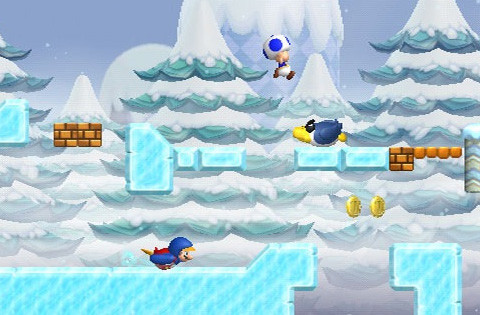
As you partake of the multiplayer side-scrolling battles in New Super Mario Bros. Wii, you'll find a penguin costume that lets your character slide around on the ice, much like the penguins from Super Mario 64. Good job, Nintendo. Throw in an ankylosaurus suit and you'll cover all of my favorite animals from my childhood.
NEWS
TATSUNOKO VS. CAPCOM DITCHES ONE CHARACTER, GETS FIVE MORE
Tatsunoko vs. Capcom was announced for a U.S. release well before E3, but Capcom put out a press release just in time for the show. According to it, the game is losing one character and gaining five new ones for the U.S. version. Capcom also alluded to online play, though they've since backed away from confirming it outright.
The new fighters are presently unknown, and the press release didn't specify which character was yanked “due to licensing issues.” However, those who've played the U.S. version claim that the roster has all of the Japanese edition's characters except for Daimaou, the genie from Tatsunoko's Hakushon Daimaou. It seems he was legally tied to another company, though some fans have speculated that he was pulled over fears that his caricatured look might offend someone.
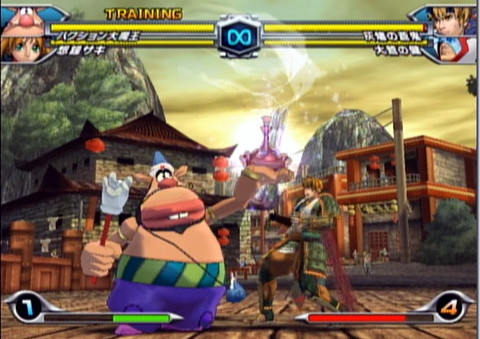
Again, that's just speculation.
SIN AND PUNISHMENT 2 LOOKS AWESOME, ITS CAST DOESN'T
Sin and Punishment 2 was first slated for 2009, but Nintendo's delayed it to next year. At least it was on hand to play at E3, and at least Nintendo's actually publishing it here. That's more than can be said for the first Sin and Punishment for the Nintendo 64, which only made it to North America through the Wii's Virtual Console.
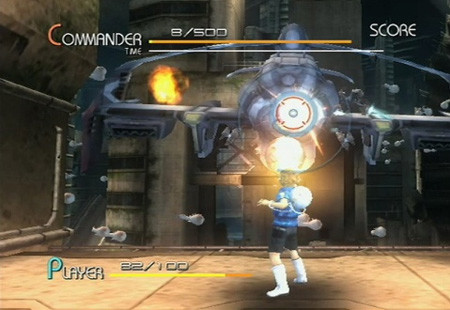
The fourth sequel attempted by Treasure, Sin and Punishment 2 is a railed shooter like its predecessor. The characters roam around in the foreground while enemies, obstacles, and gunfire head their way, but the game is hardly static. Huge creatures barrel at you, levels switch perspectives and gameplay styles, and if this sequel is anything like the first game, there should be a section where you're spinning through the air astride a piece of aircraft carrier deck. The player aims a targeting reticle with the Wii remote, while the nunchuk's analog stick controls the actual character, allowing him or her to either run on a flat surface or float through the air. Firing is the default attack, but tapping the trigger throws a close-range strike that knocks back enemies and reflects bullets. Like most of the better Treasure games, Sin and Punishment 2 seems complex but manageable.
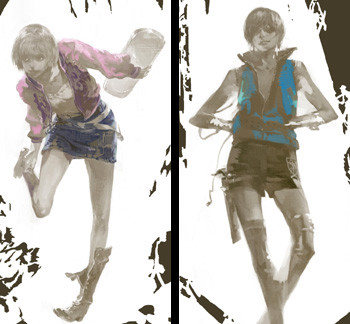
Everything about Sin and Punishment 2 looks impressive, with the exception of Isa and Kachi, the two kids that the player is evidently meant to control. They're doll-faced anime devil-children in day-glo outfits and moon boots, and even Yasushi Suzuki's art (above) makes their costumes jarring. It kills the appeal of Isa being the son of Saki and Airen from the first Sin and Punishment. Or at least their hallucinated possible future son. Sin and Punishment was a weird game.
MONOLITH TRIES AGAIN WITH MONADO
Sin and Punishment 2 was one of several notable Nintendo titles that was shown on the E3 floor but not mentioned in the company's lavish E3 address. Monado: Beginning of the World was another of these games, seen there in trailer form. Remember when Nintendo bought Monolith Soft, makers of the Xenosaga series? Well, this is what they devised for their second Wii game (their first, Disaster: Day of Crisis, came out everywhere but North America).
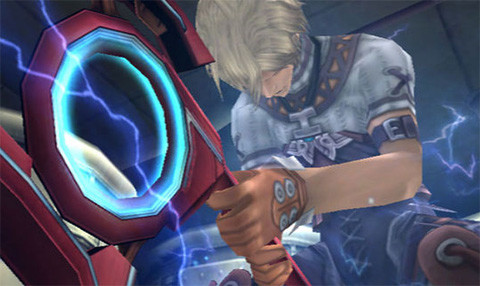
An action-RPG, Monado looks very much in the Final Fantasy vein of art direction, with sharp young adventurers taking up huge swords and fighting spindly monsters vaguely reminiscent of Xenosaga's Gnosis aliens.

It seems as though Monolith Soft still likes obscenely complicated battle systems. Seriously, just look at all of that crap on display. Perhaps it'll be intuitive when paired with Wii remote motions, although Monolith's gameplay concepts tend to be basically interesting ideas marred by many small annoyances. Monado is clearly supposed to be the breakout hit that Xenosaga almost was, and perhaps it's easier for an RPG to stand apart from the pack when it's a Wii game.
NEW CASTLEVANIA ACTUALLY AN OLDER NON-CASTLEVANIA
Konami's tried to change the Castlevania formula recently, starting with a 3-D fighter that almost nobody liked. Still, I don't think anyone expected Konami to roll out a Castlevania action game developed by a Madrid-based studio, overseen by Hideo Kojima, and introduced in a trailer by the voice of Patrick Stewart. Despite having a title that recalls those boring Wheel of Time novels, Castlevania: Lords of Shadow looks to have equal parts God of War mixed it, as it shows the lead, Gabriel, smacking around all sort of night creatures in order to resurrect his murdered wife. It's always about a dead woman, isn't it, Castlevania?
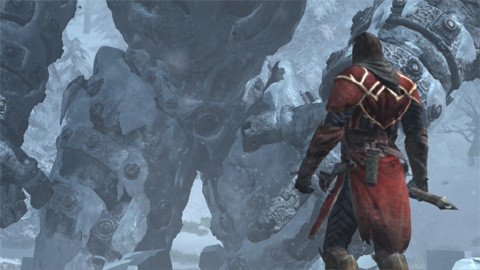
Lords of Shadow was actually shown last year, but only at this E3 did it get the Castlevania name applied. This may dissuade some longtime fans, who are surely dubious about the series being turned over to MercurySteam, a developer whose past project include American McGee's Scrapland and Clive Barker's Jericho. Perhaps Hideo Kojima's Castlevania isn't too much of a stretch for them.
SQUARE ENIX ANNOUNCES NIER, FRONT MISSION EVOLVED
Front Mission has always struggled in the West. The series wasn't even released here until Front Mission 3, and Front Mission 4 found such little success that Front Mission 5 just stayed in Japan. Square Enix might have a solution, though: get a Western developer to make a Front Mission action game. That's supposedly what Front Mission Evolved is: a third-person mecha shooter made by Double Helix.
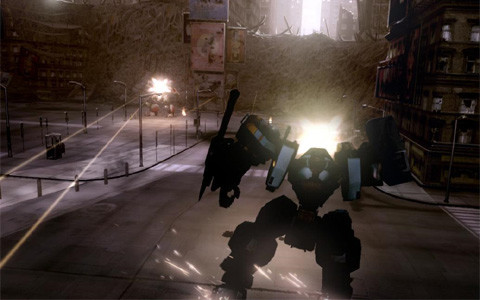
This isn't Double Helix's first time handling a Japanese franchise, as they previously made Silent Hill: Homecoming. Hell, it's not Front Mission's first time as an action game, either, since Omiya Soft made the side-scrolling Gun Hazard for the Super Famicom back in 1996.
For those who prefer humans in their violent action scenes, Square Enix recruited Cavia to make Nier, a 3-D brawler in the vein of Devil May Cry, God of War, MadWorld, and many, many other modern games. The trailer shows off a gray little city and a terrible pun involving the title. There's not much else to drive one's enthusiasm, as Cavia has a reputation for making mediocre action games, and Drakengard, their last collaboration with Square Enix, didn't draw too many fans.
IN BRIEF: IDOLM@STER ON DSI, JALECO MAKES RPGS, ZELDA ART DROPS HINTS
To be perfectly honest, the iDOLM@STER series creeps me out with its gaggle of underage pop-star princesses, but the upcoming The iDOLM@STER: Dearly Star DS game is notable. Some think that it's the first Japanese game to use the DSI hardware, based on a new trailer that briefly shows a QR Code option. QR codes are those barcode-like boxes often seen on Japanese ads and products, and snapping them with a camera phone takes to you to a relevant website. And the DSI has a camera. How that relates to the game's idol-managing element remains to be seen.
Jaleco, developer of lesser-known games since the NES era, supposedly closed down back in January, but they're not completely gone. In fact, they recently released the RPG Ougon no Kizuna in Japan (to some unkind reviews), and they're preparing another project, one called The: RPG for the moment. Jaleco's tapping the public for monster designs and concepts through the game's website, and perhaps they'll even take other ideas. At this point, I'd contribute something just because Jaleco clearly needs some help.
Finally, Zelda fans are busy speculating about this piece of concept art snatched from Nintendo's press packets.
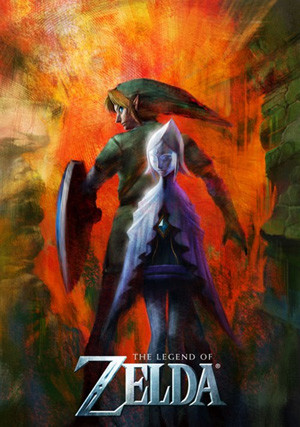
It could be part of the new Zelda DS game, Spirit Tracks, but the art has little in common with that title's cel-shaded style. Perhaps it's from a Zelda game where Link explores a world of living chess pieces.
REVIEW: FINAL FANTASY IV: THE AFTER YEARS
 Developer: Square Enix/Matrix Software
Developer: Square Enix/Matrix Software
Publisher: Square Enix
Platform: WiiWare
MSRP: 800 points for the first episode, 300 for the next seven, and then 800 for the last.
There was a time when Final Fantasy games didn't have direct sequels. Each title from the first game through Final Fantasy IX was seemingly designed to stand on its own, with no continuation of the story. It kept the series fresher than most RPG franchises, but it was a curse for the young players who loved a particular Final Fantasy too much to give it closure. Then came Final Fantasy X-2 and Final Fantasy XII: Revenant Wings and four separate Final Fantasy VII expansions, giving fans sequels without the embarrassment of having to create their own. Final Fantasy IV: The After Years is perhaps the most obscure and simple Final Fantasy follow-up; built from pieces of the original 18-year-old game, it was released for Japanese cell phones and, like many other intriguing Square-made mobile titles, it seemed unlikely to come out in English. Yet Square translated the entire game and packed it up as a multi-part WiiWare release. For those of us who always wanted more Final Fantasy IV, the reunion is both satisfying and awkward.
The After Years requires some introduction to Final Fantasy IV and how it was amazing for its day. In an age where games barely had plots, Final Fantasy IV (then called Final Fantasy II in the West) did its best to capture a melodrama of epic scale, with tragedy and adventure and catchy Super NES orchestral surges. Unlike the primitive storylines of Phantasy Star II or countless computer RPGs of the 1980s, Final Fantasy IV had characters that squabbled with each other, built relationships, and even showed traces of what snobbish literature professors call “consistent writing.” It was all far below basic fantasy fiction, but it amazed us back in 1991. It wasn't the first in the series, but the game was Final Fantasy as Western fans have always loved it: well-paced, visually striking, and filled with soaring bombast.
 Not bothering with heavy introductions, The After Years assumes that you know the particulars of Final Fantasy IV's plot. There's only a reference or two to how it involved a knight named Cecil conquering his inner demons and an invasion of lunar monsters to become a paladin-king of Baron, the nation that once exiled him. Ceodore, the son of Cecil and the white mage Rosa, starts off The After Years on a training mission with two soldiers of Baron (in retroactive Final Fantasy tradition, they're named Biggs and Wedge). Things get stranger, of course: the planet's second moon reappears, and monster attacks grow more frequent. As Ceodore's off on an island, a horde of creatures swarms over Baron's castle, with a strange blue-haired woman leading them. Several attacks later, and Ceodore ends up stranded in the wilderness, teaming up with a hooded stranger. By the end of the game's first downloadable WiiWare chapter, Ceodore has reunited with a number of Final Fantasy IV cast members and brought them back to face whatever has taken control of his homeland and its airship armada.
Not bothering with heavy introductions, The After Years assumes that you know the particulars of Final Fantasy IV's plot. There's only a reference or two to how it involved a knight named Cecil conquering his inner demons and an invasion of lunar monsters to become a paladin-king of Baron, the nation that once exiled him. Ceodore, the son of Cecil and the white mage Rosa, starts off The After Years on a training mission with two soldiers of Baron (in retroactive Final Fantasy tradition, they're named Biggs and Wedge). Things get stranger, of course: the planet's second moon reappears, and monster attacks grow more frequent. As Ceodore's off on an island, a horde of creatures swarms over Baron's castle, with a strange blue-haired woman leading them. Several attacks later, and Ceodore ends up stranded in the wilderness, teaming up with a hooded stranger. By the end of the game's first downloadable WiiWare chapter, Ceodore has reunited with a number of Final Fantasy IV cast members and brought them back to face whatever has taken control of his homeland and its airship armada.
Producer Takashi Tokita and Matrix Software (developer of the DS remakes of Final Fantasy III and IV) seem to know just how much nostalgia drives The After Years. The game not only reuses towns, caves, and other locales from the original; it uses them in ways that only dedicated fans would appreciate. Kain, Cecil's dragoon rival, has his own sub-story kicked off by a visit to the same mirrored monument that turned Cecil into a paladin years before. The second chapter of The After Years follows green-haired summoner Rydia (one of the original game's most dynamic characters) joining up with Luca, a dwarf king's daughter who was a mere supporting character in Final Fantasy IV. The two of them head into battle accompanied by two mechanical dolls named Calca and Brina…after Calcobrena, an eerie marionette boss from the first game. Wink wink and all that.
It's shameless, but The After Years still has the right aura. Even with odd-looking dialogue boxes, the game has the same crisp, overdramatic spirit as Final Fantasy IV. There are drastic sacrifices and desperate battles, pulled off with endearing style. It's never quite as new as Final Fantasy IV was all those years ago, but them's the breaks.
 There's a reason The After Years delivers the same atmosphere as Final Fantasy IV, of course: it re-uses the hell out of everything. The After Years sports reworked visuals and new sprites for every character (with the old ones amusingly employed for flashbacks), but a lot of the challenges cover familiar territory. The waterway passage to Damcyan, the tunnel under Baron, the subterranean sealed cave, and other stages are pretty much identical to their Final Fantasy IV layouts. Most of the battle graphics and enemies are repeated, and several bosses return as well. The soundtrack is also recycled from the original score, except for an ominous new tune that plays whenever the blue-tressed antagonist appears.
There's a reason The After Years delivers the same atmosphere as Final Fantasy IV, of course: it re-uses the hell out of everything. The After Years sports reworked visuals and new sprites for every character (with the old ones amusingly employed for flashbacks), but a lot of the challenges cover familiar territory. The waterway passage to Damcyan, the tunnel under Baron, the subterranean sealed cave, and other stages are pretty much identical to their Final Fantasy IV layouts. Most of the battle graphics and enemies are repeated, and several bosses return as well. The soundtrack is also recycled from the original score, except for an ominous new tune that plays whenever the blue-tressed antagonist appears.
Final Fantasy IV's battle system was sturdy enough for its day, and The After Years makes few changes. Enemies are still encountered at random, parties hold up to five characters, and battles are real-time, menu-based clashes. Each party member has some type of special move, and The After Years takes it one step further by giving some of them team-up attacks. The results are similar to Chrono Trigger's dual and triple techs, though The After Years makes you spend a turn scanning characters for possible combined moves. It's not the first game to try this, but it adds a lot to a standard-issue battle interface.
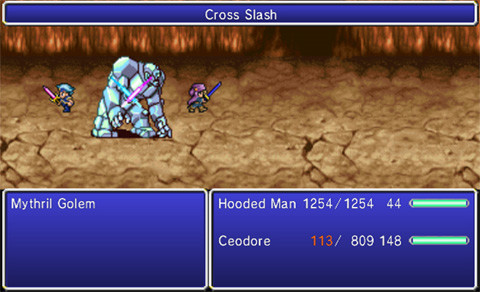
The other major combat addition tracks the moon's phases and shifts powers accordingly. One phase may boost white magic and weaken black magic, while another might make physical attacks less powerful. Some monsters show up more frequently during certain stages of the moon, and a few only appear during one particular phase. The changes are rarely serious enough to make a difference between victory and defeat, and the player can always speed up the lunar state by using tents and staying at inns. So far, the battles are reasonably tough; after an initially simple run with Ceodore, the game serves up enemies that can actually kill you. There's a decent old-school challenge in there, though Matrix never makes it quite as brutal as the DS version of Final Fantasy IV. Unfortunately, part of that challenge arises just because the battle rate is irksomely high, probably to keep the game's episodes from seeming too short.
Like its battles and scenery, the storyline of The After Years offers a lot of repetition. It's one thing to bring back the second moon and invoke conquest by airship, but the first chapter of The After Years piles on the callbacks with cloying eagerness. An evil force is using Baron and its airships to steal the world's crystals? Kain's not himself and wants to kill Cecil so he can have Rosa all to himself? Rosa doesn't do much of anything? The After Years brings all of that back from Final Fantasy IV. If you liked it once, you'll love it twice!
 Once could argue that The After Years has no reason to exist. Final Fantasy IV had a straightforward story that wrapped up nicely, and there were no characters left absent or large plot threads left un-addressed (compared to, say, Final Fantasy VI and the amazing disappearing Banon). A sequel trudges into the realm of company-sanctioned fan fiction (that's hardly new ground for the scriptwriters from Studio Bent Stuff, since they've written stories for various Final Fantasy guide books). Yet it's hard to deny that The After Years is captivating for those of us who liked Final Fantasy IV years ago. We want to see Kain conquer his jealous dark side, we want to fly an airship over the magma lakes of the underworld, we want to see mage-kid Palom being a pompous little brat while his sister Porom is responsible and proper, and we want to find out if Rydia and the cocky ninja-prince Edge ever hooked up. If it's fan bait, what we have so far is at least enjoyable fan bait.
Once could argue that The After Years has no reason to exist. Final Fantasy IV had a straightforward story that wrapped up nicely, and there were no characters left absent or large plot threads left un-addressed (compared to, say, Final Fantasy VI and the amazing disappearing Banon). A sequel trudges into the realm of company-sanctioned fan fiction (that's hardly new ground for the scriptwriters from Studio Bent Stuff, since they've written stories for various Final Fantasy guide books). Yet it's hard to deny that The After Years is captivating for those of us who liked Final Fantasy IV years ago. We want to see Kain conquer his jealous dark side, we want to fly an airship over the magma lakes of the underworld, we want to see mage-kid Palom being a pompous little brat while his sister Porom is responsible and proper, and we want to find out if Rydia and the cocky ninja-prince Edge ever hooked up. If it's fan bait, what we have so far is at least enjoyable fan bait.
What we have so far is also needlessly expensive. The first chapter, which technically includes both the Ceodore and Kain arcs, is 800 Wii Points (or eight dollars), and the Rydia-based chapter is 300. The next six chapters, each focusing on a different character, will be released in the coming months for 300 each, and the last will cost you another 800. That's a grand total of $37 if you want the entire game, and it's an unprecedented sum for a download-only title that uses Super NES graphics. Granted, the chapters promise to be reasonably long: the first is about five hours, Rydia's is roughly three (four if you want the best ending, and you will), and each has a bonus dungeon available after you're finished with the story-based part. Still, I imagine the cost will dissuade a lot of fans. Square Enix would've charged $39.99 for The After Years if it were a DS game, but at least you'd get a case and instructions with it.
Is Final Fantasy IV: The After Years overpriced? Probably. Is it unnecessary? Perhaps. Yet its first course is faithful to its legacy, with solidly crafted battle mechanics, intriguing new pieces of the world, and the same air of engaging adventure that drew people to Final Fantasy IV in the first place. It's not 1991 and we're not easily enraptured kids anymore, but The After Years might just remind us that we were. For all of its cheap tactics and recycled parts, this sequel does justice to the first great Final Fantasy, and that's reason enough for it to exist.
RELEASES FOR THE WEEK OF 6-14
FLOWER, SUN, AND RAIN There's on ongoing debate over Goichi “Suda51” Suda's motives: is he a stylish, clever new talent or an industry-mocking jerk who puts out barely playable claptrap and giggles over each paycheck? Killer 7 and No More Heroes didn't put an end to these debates, and I doubt that Flower, Sun, and Rain will either. Yet it'll give Suda's fans further insight into his creative processes, as Flower, Sun, and Rain was made by Suda before he was fashioning bizarre action games like No More Heroes. Released quietly on the Japanese PlayStation 2 back in 2001, Flower, Sun, and Rain is an adventure game, meaning that its lead, a professional searcher named Mondao, wanders around finding objects, solving puzzles, and talking with strange and possibly unsavory characters. This is also a Suda51 game, so Mondo solves many puzzles by plugging objects into a code-cracking briefcase named Catherine. The game operates on that sort of malleable dream logic as Mondo tries to solve the mysteries of an island where the same day repeats constantly, ending each time with an exploding plane. It's an idea that's been done before in movies and even in games (ask devoted RPG fans about Ephemeral Phantasia and watch them cringe), but never with a subplot about a pink crocodile or gameplay that might just be making fun of you, the player. The DS version of the game degrades the visuals a little, even though semi-crude polygon people might fit the mood of Flower, Sun, and Rain.
|
LET'S TAP Developer: Prope
Developer: Prope Publisher: Sega Platform: Wii MSRP: $29.99 Let's Tap may not seem a standout among the eight thousand multiplayer party games on the Wii, but it's getting mentioned here for two reasons. One, it's the work of Yuji Naka, key designer of Sonic the Hedgehog and other Sega classics. Two, it was advertised in Japan as a game that even a penguin could play. Let's Tap puts the controller atop a small cardboard box and has the player interact by striking (or pecking) the box itself, and never the controller. This may draw the ire of fans who think the Wii is killing whatever “hardcore” gaming is (“A game where you don't even touch the controller? Heresy! Where's Burning Rangers 2 and all the porn comics it would surely create?”), and yet it sounds like fun in a rhythm-game way. The actual mini-games come from the Mario Party school, with hurdle jumping and balloon inflating and tower balancing and other things that sound vaguely like Internet fetishes when you try to describe them. There's more complex fare, of course, including a shooter where the player's taps guide a Sonic-like figure through a minefield. It's also knit together with techno soundtracks, neon-frame visuals, and the exact same deep synthesizer voice that we heard in Lumines. I'm sure there are penguins in there, too. Also shipping: the multi-platform Ghostbusters games. If there were a Ghostbusters anime, I could justify a full write-up, but… |
discuss this in the forum (53 posts) |
this article has been modified since it was originally posted; see change history
 Developer: Grasshopper Manufacture
Developer: Grasshopper Manufacture